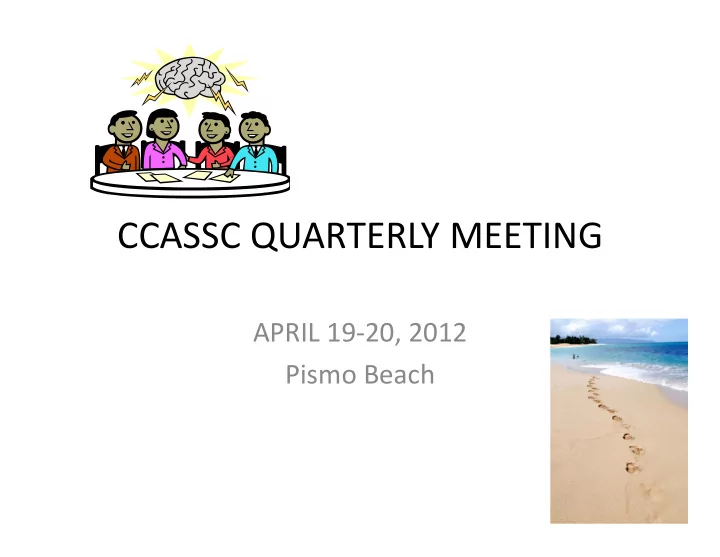

CCASSC QUARTERLY MEETING APRIL 19 ‐ 20, 2012 Pismo Beach
2030 WORKLOAD STUDY • method for allocating basic Child Welfare Services (CWS) resources based on caseload standards and average monthly case counts • Used to estimate the # of FTE required to provide basic CW services • Final report issued 2000
Original Goals of the study • 1. To understand the routine activities of child welfare staff in fulfilling their duties; • 2. To understand the time needed to complete all mandated practice activities; • 3. To estimate the time required to engage in child welfare practice that can be considered best practice or state ‐ of ‐ the ‐ art • 4. Review of the budgetary methodology for statewide Child Welfare Services and for county level allocations.
Workload Standards Cases per Social Worker Emergency Response Emergency Family Family Permanent Assessment Response Maintenance Reunification Placement 1984 Workload Standards 322.5 15.8 35.0 27.0 54.0 SB 2030 Standards: Minimal 116.1 13.0 14.2 15.6 23.7 Optimal 68.7 9.9 10.2 11.9 16.4
CWLA Standards • Goal is to ensure safety, permanency, and well ‐ being for all children who come to the attention of the child welfare system. • Focus on what it takes to achieve these service goals. “ In the federal Child and Family Service Reviews, those states that showed strength in such areas as family involvement and worker contact with children in foster care were more likely to achieve safety and permanency goal s. “
CWLA standards • Initial CWLA standards first published in 1994 • In 2004 CWLA standard of 12 cases per worker, per month for investigations; 17 families for in home services; and 12 ‐ 15 children for children in out of home care
Arizona final report on recommended caseload standards July 2004 Caseload standards by case type: • Open Close = 24 hours/case = 3.8 cases/per month • Open/Close = 24 hours/case = 4.8 cases/per month (using • alternative leave figure) Services Only = 37.33 hours per case = 2.5 cases/per month • Services Only = 37.33 hours = 3.08 cases/per month (using • alternative leave figure) Dependency = 76.98 hours per month = 1.2 cases/per month • Dependency = 76.98 hours per month = 1.5 cases/per month (using • alternative leave figure)
NASW W orkload and Case Sizes • Administrators to ensure that caseloads are manageable so that services are delivered and clients have access to the workers. • Administrators must not only monitor caseload size but other responsibilities of the workers.
Caseload size issues • Non case carrying workers • Specialized caseloads ‐‐‐ court; ILP; AB12…. • Realignment
Recommend
More recommend